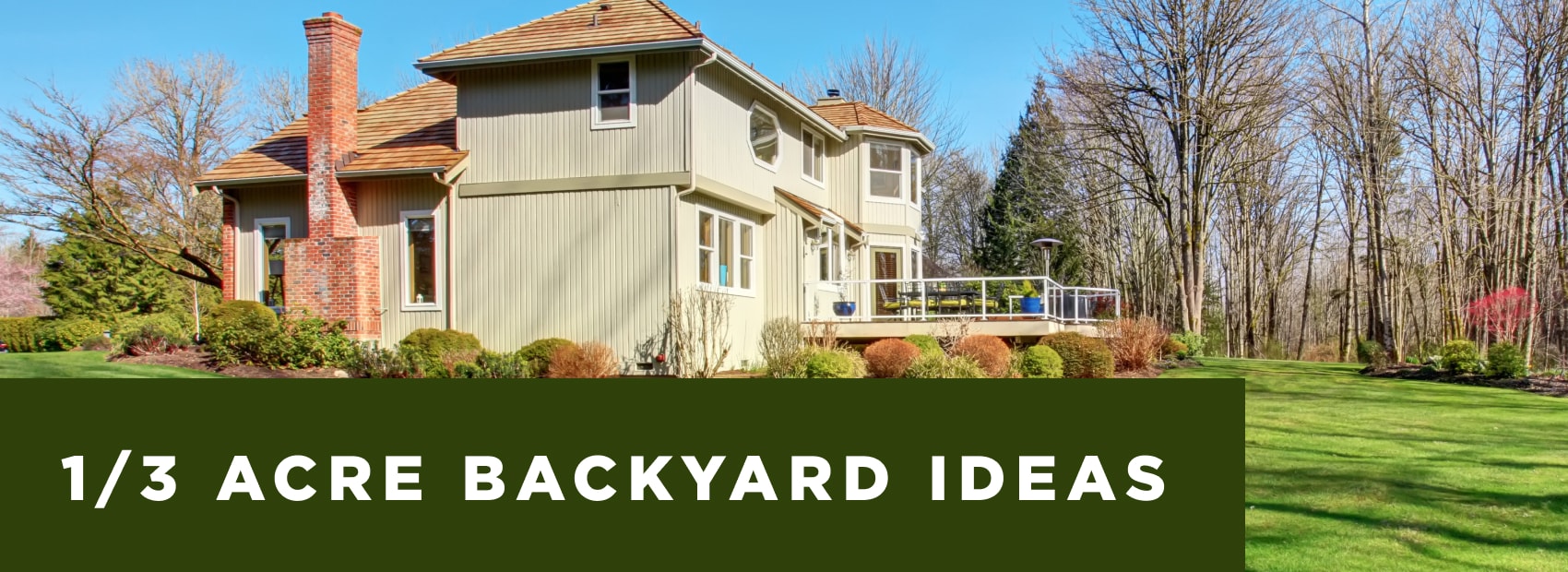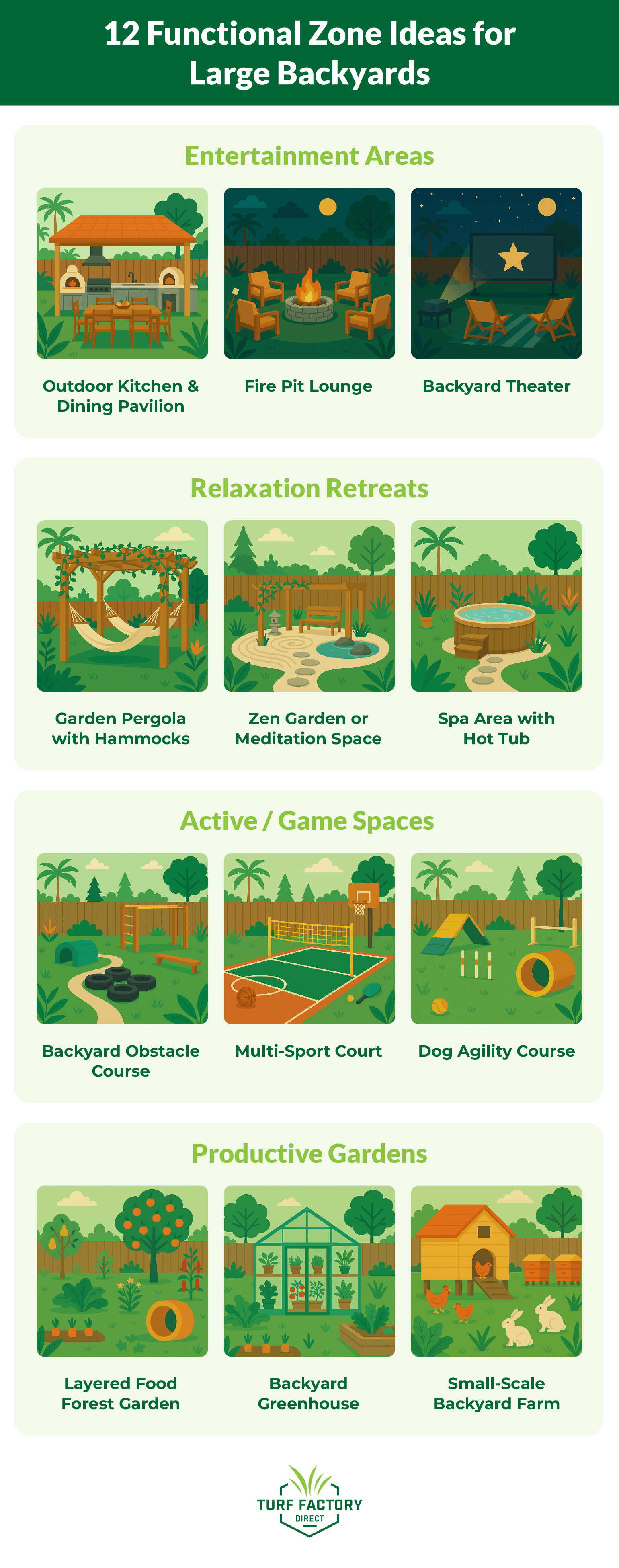
Ever look out the window and feel like your large backyard is quietly judging you? All that space, just sitting there, patchy grass and forgotten corners, when it could be so much more. With the right 1/3 acre backyard ideas, you can turn that blank canvas into a sanctuary that reflects your lifestyle and values. A hidden garden to calm your mind, a gathering place where friends linger long past sunset, a sanctuary that feels like you.
Your 1/3 acre lot has the bones for something amazing. With a bit of planning, you can layer in native plants, smart irrigation, and easy-care paths. The space is big enough to create distinct areas that work together beautifully without feeling overwhelming.
In this guide, you’ll find layout strategies, practical landscaping ideas, and inspiration to transform your backyard into a retreat you’ll love coming back to, season after season.
Key Takeaways
- A 1/3 acre lot gives you enough space to create multiple zones that flow together visually and functionally.
- Using native plants and layout strategies reduces upkeep and boosts ecological value.
- Smart 1/3 acre backyard ideas turn an everyday yard into a place for connection, nourishment, and personal recharge.
Planning Your 1/3 Acre Paradise
A large yard holds endless possibilities. With proper planning and the right 1/3 acre backyard ideas, you can strike a practical balance between gardening, relaxing, entertaining, and making room for useful extras like tool storage or composting.
Assessing the Dimensions and Characteristics of a 1/3 Acre Lot
A 1/3 acre lot is typically around 120 feet by 121 feet (14,520 square feet), though shapes vary. You’ve got enough ground to establish several zones without the yard feeling disconnected or chaotic.
Typical size breakdowns might include:
- 2,000–3,000 sq ft for a working garden
- 1,000–1,500 sq ft for a patio, deck, or lounging area
- 500–1,000 sq ft for tools or storage
- The rest for lawns, ornamental beds, or trails
A rectangular shape works well for aligning zones to sunlight. This is especially valuable if you want to grow food crops or keep solar-heated seating areas comfortable well into autumn evenings. Positioning the house so that your southern yard exposure is open gives your growing areas a big advantage.
Conduct a Site Analysis to Identify Existing Features, Sun Patterns, and Drainage
Tracking how the sun moves across your property over a few days, or better yet, different seasons, can help you map growing potential and shaded spots. Sun chart apps are a helpful shortcut here.
Take stock of:
- Large trees, hedges, or major plantings
- Slopes or dips that might collect or shed water
- Utility lines that could limit digging or tree planting
- Hot or cool microclimates created by hard surfaces or walls
Rainfall patterns matter too. Walk the yard during or just after a storm to see where water collects or moves fastest.
Create a Scaled Map to Visualize Potential Zones and Traffic Patterns
Sketch your layout on graph paper or digitally at a scale like 1 inch = 10 feet to get a true sense of space and connection.
Sketch these core areas:
- Quiet spots close to the house
- Productive areas with full sun
- Functional workspaces
- Natural spaces for wildlife
Use rough “bubble” shapes at first to play with ideas. Then map paths at least 4 feet wide between zones so movement stays easy and comfortable. Imagine toddlers racing toy trucks along the paths or you carrying a tray of drinks to an outdoor dining table without feeling cramped.
Consider Local Zoning Regulations and HOA Restrictions Specific to Your Property Size
Most neighborhoods place limits on structures and property uses. A 1/3 acre lot often sits in residential zones with rules about:
- Setbacks from lot lines and structures
- Maximum percentage of land that can be built on
- Structure height or building type
- Rules about raising chickens, bees, or other small animals
Double-check rules related to:
- Fencing materials and heights
- Greenhouse or shed square footage
- Water features and grading changes
- Any visible outdoor structures or garden projects
Before adding anything permanent, review your city’s permit checklist. Starting early gives you time to sort paperwork and avoid costly surprises down the line.
Establishing Functional Zones
Dividing your yard into dedicated areas gives it rhythm and usefulness. Every corner can spark a different feeling: the hush of a hidden retreat, the buzz of a dinner party, the laughter of kids at play. All while still feeling like part of the same landscape.
Divide Your 1/3 Acre Into Purposeful Areas
Start by mapping rough quadrants that follow light exposure and how people naturally move through the space. For instance, a play area might sit close to the back door for easier watching. Something like a soft patch of turf where toddlers can tumble barefoot.
Low-traffic areas are better for calm zones or lush planting. These become peaceful pockets you’ll actually use, instead of ignored corners. Keep backyard zones for entertaining close to your kitchen or utility hookups for convenience. This is a core principle in successful 1/3 acre backyard ideas that prioritize flow and function.
Pay attention to the parts of the yard you can’t change, like mature trees or slopes. Let those elements help dictate your layout. Use natural features to frame views or create hidden nooks that feel like little discoveries.
Create a Balanced Layout That Maximizes Usable Space Without Feeling Crowded
Plan for ease of movement by leaving generous 3-4 foot walking paths between areas. Flow matters more than symmetry here. It helps you enjoy the space daily instead of feeling hemmed in.
Make the most of vertical space. Use lattice walls or pergolas to add privacy or divide areas without using up precious square footage. Benches with hidden storage offer double functionality. These details keep things uncluttered, which means less time tidying and more time relaxing.
When placing structures, think about what you’ll want to see and what you won’t. Consider whether you’ll be staring at a blank fence or a view that makes you feel good to be home.
Have Clear Transitions Between Zones While Maintaining Visual Cohesion
Choose a few repeating elements, like a type of paver, a gravel color, or a favorite shrub, to create a sense of flow. These touches tie everything together so the space feels intentional, not random.
Physical separators like pergolas, arbors, or short retaining walls signal shifts in use while still keeping everything visually linked.
Layered lighting helps too. Path lights, soft uplights, and string lights define spaces and stretch outdoor use into the evening hours. This makes the yard feel welcoming even after dark, so you actually use it more often.
Allocate Appropriate Square Footage for Each Zone Based on Family Priorities
Here’s a rough guide for a four-person household:
- Entertainment: 25–30%
- Active/play space: 20–25%
- Food growing: 20–25%
- Chill zones: 15–20%
- Connecting paths: 10%
These ratios are flexible. Just match them to what brings you joy. If you’re working from home, carving out a shaded spot for a desk can help you focus without feeling cooped up indoors. For families, a visible play space reduces worry and keeps everyone together. For retirees, low-maintenance paths and raised beds can make gardening easier and more enjoyable.
Entertainment Areas
Want to impress guests? Use 1/3 acre backyard ideas that combine hardscape, lighting, and native plants to create immersive backyard zones for entertaining. Aim for a 15×20 foot area for your core hangout space, big enough for a dining table and a grill setup.
Built-in L-shaped benches around a fire pit or coffee table save space and create cozy corners.
Don’t forget weather-resistant plug-ins, ambient lights, and secure storage for your favorite hosting accessories. A discreet cabinet can hide speakers, candles, and extra throws for chilly nights.
Relaxation Retreats
Locate peaceful spots away from active or noisy zones. Even a compact 12×12 space works for a lounge chair, water feature, and plantings.
Privacy hedges, bamboo screens, or tall grasses can make even open areas feel tucked away. A small pergola can help mark the space while adding support for climbing greenery.
Scented herbs, textured plants, and soft wind sounds go a long way toward making this area feel calming. Adding calming elements now, like textured plants or a simple water feature, makes it easier to unplug later when stress builds up.
Active Spaces
Keep at least 400 sq ft open for movement and games. This ensures everyone has room to move, whether for kids, adults, or pet companions.
Soft surfaces like rubber mulch or play-safe artificial turf reduce injuries. These areas are perfect for portable sports equipment or a freestanding playhouse. A pop-up soccer goal or a chalkboard wall adds fun without permanent clutter.
Storage close to the play zone keeps things tidy. Choose lidded deck boxes or weatherproof benches with interior bins.
Productive Gardens
Choose a sunny southern spot for raised beds. The 4×8 bed is a garden favorite, manageable and modular.
Maximize space with upright features like trellises or cattle panels for crops like beans, peas, or squash. They double as garden walls too. Their green curtain gives you privacy and fresh food at once.
Tuck compost bins and a compact potting shed nearby. Chickens? A 10×10 coop fits snugly next to the veggie patch and supplies both eggs and compost boost.
Match irrigation to zones with similar water needs. Drip systems save water and reduce weed growth. Install them early in spring so you’re ready before the first heat wave hits.
Implementing Sustainable and Beautiful Design Elements
Beauty and function can absolutely live side-by-side when you design with purpose. Great landscaping brings comfort, supports the environment, and keeps your space easy to manage over time.
Landscaping Fundamentals
Use native plants as your foundation. They’re already adapted to your conditions and usually need less care. They’ll also attract birds and butterflies, adding life and movement you’ll notice the moment you walk outside.
Group plants by water requirements to help your irrigation system work smarter. That’s the principle behind hydrozoning. This cuts down on waste and saves money, especially when summer heat peaks.
Layer heights to create depth and interest. Start with taller elements at the back and step down to shorter ones. This mimics natural ecosystems and helps wildlife.
Choose a color palette, like cool tones or warm hues, and repeat elements across flower beds and planters to tie everything together.
For areas where grass struggles or maintenance is a hassle, consider installing low-maintenance artificial turf. It’s a smart solution for homeowners who want year-round greenery without the constant upkeep, especially in shaded corners or high-traffic zones.
Hardscape Elements
Choose walkways that let water pass through. Gravel, spaced stone, or permeable pavers reduce runoff and feel more integrated into the landscape.
Build garden beds using materials that blend well with nature, like salvaged brick or untreated wood.
If you plan to add fencing, choose designs that match the home’s aesthetic and use materials that weather well without chemicals, like cedar.
Arbors and screens add both structure and vertical growing space, ideal for flowering vines or beans. Consider a grape arbor near your patio to provide summer shade and fresh fruit within arm’s reach.
Water Management
Capture roof runoff using rain barrels. Link those into your drip irrigation to cut down on tap water usage. This is especially helpful in drought-prone areas or if you’re trying to lower utility bills.
Use swales or gently contoured rain gardens to direct runoff where it can soak in and benefit plants.
Smart irrigation controllers adjust watering to weather and reduce waste. Keep plants with similar water needs on shared lines.
Ponds or small fountains support wildlife and make the space feel cooler and more soothing.
Practical Considerations
Set up compost bins where they’re easy to reach from both the house and garden. A triple-bin system is efficient and scalable.
Design shelters or pens for chickens, quail, or rabbits with good airflow and clean access. Keep them near food gardens if possible. This setup turns waste into fertilizer and makes tending animals part of your daily rhythm.
Group labor-intensive spots, like veggie beds or greenhouse zones, closer to your main path or house for easier upkeep. It’s easier to pull a few weeds when your garden is steps from the kitchen door.
Solar panels can power sheds or lights and work best when tucked into pergolas or smaller roofs.
Seasonal Planning
When exploring 1/3 acre backyard ideas, factor in seasonal transitions—this is one of the smartest backyard transformation tips to keep your yard thriving year-round. Start by mapping the sun angles throughout the seasons to get planting zones right. Even minor shifts change how certain beds perform. A spot that looks perfect in March could bake in July.
Choose plants with seasonal interest: bulbs for spring, long-blooming perennials for summer, colorful foliage for fall, berries or bark texture for winter.
Add covered zones so you can enjoy the yard into late fall. Awnings, gazebos, or open-roof shelters extend outdoor seasons comfortably.
Use deciduous trees to shade in summer while letting light through in winter, perfect for southern exposures. This simple move can keep patios comfortable and reduce cooling costs indoors.
Sustainability Features
Support pollinators with flower selections that bloom across multiple seasons. Stick with native plants where possible for best results.
Create simple wildlife havens. Brush piles, native grasses, or berry shrubs help birds and beneficial insects thrive.
Install LED lights on timers or motion sensors to lower energy use. Try solar path lights or lanterns to cut wiring needs.
Interested in bees? With space and the right layout, a backyard hive can support nearby gardens and offer a little honey too. Just position it away from high-traffic paths.
Bring Your Backyard Vision to Life
Your 1/3 acre yard has so much potential; whether you crave a lush retreat, a playful family hub, or a low-maintenance space that simply makes you smile every time you step outside. Every step you take to plan, design, and invest in sustainable touches moves you closer to a backyard that feels like an effortless extension of your lifestyle. If you’re tired of staring at patchy grass and wondering what could be, now you know where to begin.
Ready to start transforming your space into something extraordinary? Check out our premium artificial turf and landscape materials and take the first step toward a backyard you’ll love, season after season. Whether you’re designing backyard zones for entertaining or crafting a peaceful garden nook, the right inspiration and tools will make it happen.








